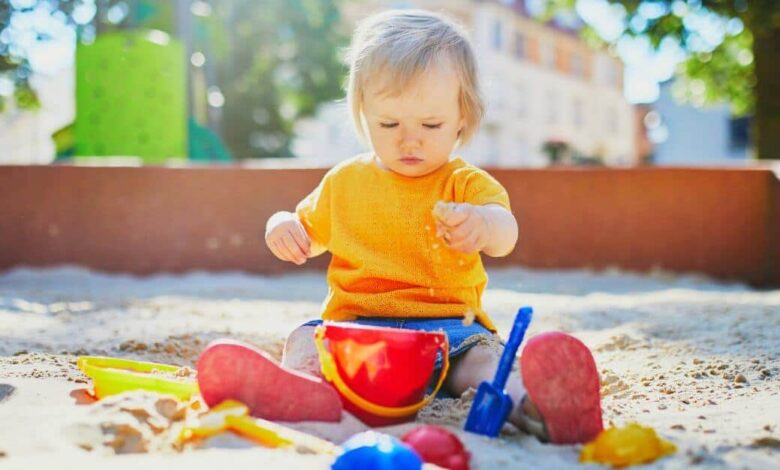10 Benefits Of Sandpit Play For Toddlers

Share The Mummy, it’s OK Love!
Playing in the sandpit is a popular activity for young children, especially toddlers. Playing in the sandpit provides a fun and interactive experience that can benefit their development in many ways. In this blog post, we’ll explore 10 benefits of sandpit play for children.
1. Sensory Development:
Playing in the sandpit is a sensory experience for toddlers. They can feel the texture of the sand in their hands and feet, hear the sound of the sand as it moves, and see the different shapes and patterns it can create. This sensory input helps toddlers develop their sensory processing skills and gain a better understanding of the world around them.
2. Fine Motor Skills:
Playing with sand requires the use of small muscles in the hands and fingers, which helps children develop their fine motor skills. They can use their hands to scoop, pour, and mold sand, which strengthens their hand-eye coordination and improves their dexterity.
3. Imagination and Creativity:
Playing with sand offers children the opportunity to use their imaginations and be creative. They can build sandcastles, pretend to cook with sand, or create their own imaginary worlds. This type of play fosters creativity and helps children develop problem-solving skills.
4. Social Skills
Playing in a sandpit with other children provides an opportunity for social interaction. Children can work together to build structures or play together in imaginary scenarios. This type of play helps children develop their social skills and learn how to communicate and share with others.

5. Language Development
Playing with sand can also help with language development. Children can use words to describe the actions they take, the things they do, and the imaginary scenarios they create. This type of game encourages communication and helps children develop their language skills.
6. Cognitive Development:
Sandpit play can also benefit a child’s cognitive development. Children must use their problem-solving skills to build structures and navigate imaginary scenarios. They must also use their memory and visualization skills to remember the details of their imaginary worlds.

7. Physical Development:
Playing in the sandpit is a physically active experience for toddlers. They must use their muscles to move and manipulate the sand, which helps with gross motor development. This type of play also helps with balance and coordination.
8. Rest
Playing in the sandpit can be a relaxing activity for children. Playing with sand can be calming and soothing, helping children manage stress and anxiety.
9. Playing Outside:
Sand play activities often take place outdoors, allowing children to enjoy the benefits of fresh air, natural light, and physical activity. Engaging in sand play encourages movement, as young children dig, build, and manipulate sand, developing fine motor skills, hand-eye coordination, and overall physical development.
10. Parent-Child Bonding:
Sandpit play can also provide an opportunity for parent-child bonding. Parents can join in the play, help build structures or play out imaginary scenarios with their child. This type of play helps parents and children develop a closer relationship and fosters a sense of trust and security.
11. Emotional Development:
Sand play activities offer a safe and open environment for toddlers to express their feelings. They may experience a variety of emotions, from joy and excitement to frustration or disappointment, as they explore and experiment in the sand. Sand play can be a soothing and calming activity that allows toddlers to release any pent-up emotions and reduce stress.
12. Mathematical Concepts:
Playing with sand can introduce basic math concepts to children. They can explore concepts like volume, measurement, and weight as they compare the amount of sand in different containers or experiment with pouring and filling. They can also practice counting, sorting, and sorting objects in the sand.
13. Scientific Exploration:
Sand play provides an opportunity for toddlers to engage in basic scientific exploration. They can experiment with mixtures of water and sand to create wet sand. Then observe how it changes the texture or consistency. They can explore concepts such as sinking and floating by placing objects in the sand and observing the outcomes. Dry sand and wet sand play Sand play is really a wonderful sensory play activity for toddlers. The natural texture of sand provides a rich sensory experience that engages multiple senses and promotes sensory development.
Conclusion
In conclusion, sandpit play offers many benefits for toddlers. From sensory development to social skills, cognitive development to physical activity, sandpit play is an engaging and interactive experience that helps children learn and grow in many ways. If you have a toddler, consider adding a sandpit to your backyard or local park and watch as they discover the joy of playing in the sand.





